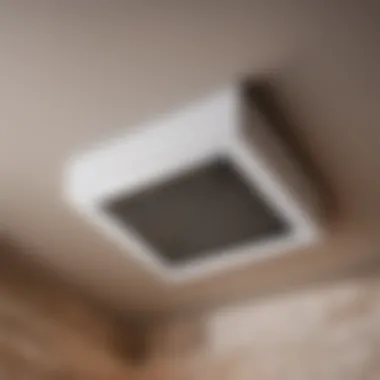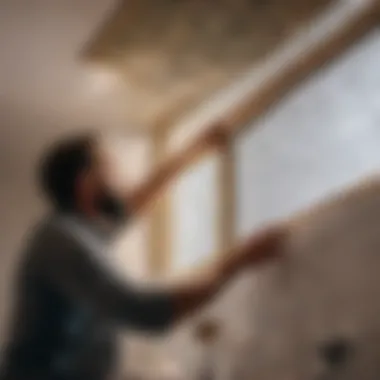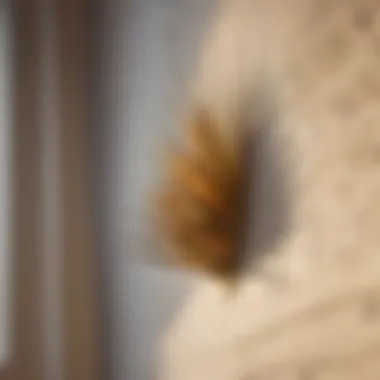Discover the Ultimate Guide on Bird-Proofing Your Bathroom Vent


Materials:
- Metal vent cover (dimensions: 6 x 6 inches)
- Hardware cloth or wire mesh (size: 1/2 inch)
- Tin snips
- Screwdriver
- Gloves
- Safety goggles
- Marker
- Measuring tape
- Sealant (weatherproof)
DIY Steps:
- Preparation: Start by gathering all the materials required for bird-proofing your bathroom vent, ensuring you have everything at hand to proceed smoothly.
- Assessment: Examine the size and shape of your vent to determine the appropriate dimensions for cutting the hardware cloth or wire mesh.
- Cutting Mesh: Using tin snips, carefully cut the hardware cloth to match the measurements of your vent cover, ensuring precision to prevent any gaps once installed.
- Installation: Place the metal vent cover over the opening and attach the cut mesh on top, securing it with screws to ensure a tight fit that prevents birds from entering.
- Securing Mesh: Apply sealant around the edges of the mesh to weatherproof the installation and prevent any potential rusting or degradation.
Technical Aspects:
- Timing: Allocate approximately 30-45 minutes for this DIY project, ensuring you have sufficient time to complete each step meticulously.
- Tools: Apart from the hardware listed, having a ladder for accessing the vent height is essential for a safe and effective installation.
- Techniques: Precision cutting of the mesh is crucial to creating a secure barrier against birds while ensuring proper ventilation.
DIY Project Process:
- Start Planning: Begin by mapping out the steps involved, from measuring the vent to acquiring materials, to streamline the process effectively.
- Executing Installation: Follow the detailed instructions provided to align and secure the mesh over the vent cover, paying attention to ensure a seamless and secure fit.
- Troubleshooting Tips: In case of gaps or loose fittings, revisit the installation steps to reinforce the mesh and sealant, ensuring a robust barrier against bird intrusion.
Introduction
In the realm of household maintenance, ensuring the integrity of your ventilation system is paramount, with particular emphasis on areas vulnerable to bird intrusion. This comprehensive guide delves into the intricate process of bird-proofing your bathroom vent, shedding light on essential strategies and methodologies to safeguard your home against avian interference. As homeowners, it is critical to recognize the detrimental impact of birds nesting in vents, ranging from blockages and air quality issues to potential structural damage. By proactively securing your bathroom vent, you not only protect your property but also enhance the overall functionality and longevity of your ventilation system.
Throughout this article, we will unravel the complexities surrounding bird-proofing measures, offering invaluable insights and practical solutions for mitigating risks associated with avian infestation. From the initial assessment of your vent system to the meticulous installation of protective covers and ongoing maintenance routines, each step is crucial in fortifying your home against unwanted avian guests. Emphasizing the significance of a bird-free ventilation system, this guide propels homeowners towards a secure and harmonious household environment. Whether you are a seasoned homeowner or new to the nuances of vent protection, this article caters to individuals seeking a comprehensive understanding of bird-proofing techniques tailored for residential spaces.
The essence of this exploration transcends mere precautionary measures; it embodies a proactive stance towards safeguarding your property and ensuring the seamless operation of your bathroom vent. Envision a home environment free from avian disturbances, where ventilation systems function optimally without the threat of bird-related complications. Join us on a journey through the meticulous art of bird-proofing bathroom vents, where every deliberation and implementation paves the way towards a resilient and bird-free household.
Understanding the Issue


Birds nesting in bathroom vents can present significant challenges for homeowners. Understanding these issues is crucial to effectively bird-proofing your vent system. Not only can bird infestation cause unpleasant odors, noise disturbances, and potential health hazards from droppings, but it can also lead to blockages, which may compromise the ventilation system's efficiency. By comprehensively addressing the factors contributing to birds nesting in vents, homeowners can ensure a clean, safe, and properly functioning vent system.
Potential Problems of Birds in Bathroom Vents
Birds nesting in bathroom vents pose various problems. Firstly, their droppings can accumulate over time, causing foul odors and potential health risks. Moreover, the presence of birds can lead to blockages, impeding proper airflow and ventilation. Additionally, the nesting materials used by birds can clog vents, creating fire hazards. Addressing these issues promptly is essential to maintain a hygienic and safe home environment.
Types of Birds That Commonly Nest in Vents
Several bird species are known to nest in bathroom vents, including sparrows, starlings, and pigeons. These birds are attracted to vents due to their warmth, shelter, and seclusion. Sparrows, for instance, are known for building nests in small holes or crevices, making vents an ideal nesting spot. Starlings, on the other hand, are adept at adapting to urban environments and may nest in vents year-round. Understanding the nesting behaviors of these common bird species is key to implementing effective bird-proofing strategies.
Assessing Your Vent System
When it comes to bird-proofing your bathroom vent, assessing your vent system is a crucial step that should not be overlooked. By thoroughly examining the design and vulnerabilities of your vent, you can identify potential entry points for birds and take proactive measures to prevent them from nesting.
Vent Design and Vulnerabilities
Vent design plays a significant role in determining the vulnerabilities of your system. Different vent configurations may have varying levels of susceptibility to bird intrusion. Some vents may feature larger openings or gaps that make it easier for birds to access the interior.
It's essential to closely inspect the vent design to recognize any weaknesses that could serve as an entry point for birds. Common vulnerable areas include loose vent covers, damaged screens, or gaps between vent segments that allow birds to sneak in.
To address these vulnerabilities effectively, consider investing in sturdy vent covers and ensuring that all components are securely fastened. By fortifying the design of your vent system, you can create a formidable barrier against avian invaders.
Locating Entry Points for Birds
Birds are opportunistic creatures that can exploit even the smallest openings to gain entry into your vent system. By actively searching for potential entry points, you can preemptively block off these access routes and deter birds from setting up nests.
Start by examining the exterior of your vent to spot any visible gaps, cracks, or areas where birds might squeeze through. Additionally, check the surrounding areas for nearby tree branches or structures that could provide birds with easy access to your vent.


Using a flashlight or mirror, inspect the interior of your vent to identify any signs of bird activity or nesting. Look for nesting materials, feathers, or droppings that indicate birds have already made themselves at home.
Once you've pinpointed these entry points, seal them off using appropriate materials like silicone caulk or wire mesh. By eliminating potential entryways, you can effectively bird-proof your bathroom vent and maintain a peaceful coexistence with our feathered friends.
Methods for Bird-Proofing Bathroom Vents
When it comes to bird-proofing your bathroom vents, employing effective methods is crucial to safeguarding your space from avian intrusions. By implementing the right bird-proofing techniques, you can prevent birds from entering and nesting in your vent system, ensuring proper ventilation and avoiding potential damages.
Installing Vent Covers
Types of Vent Covers:
Types of vent covers play a vital role in securing your bathroom vent. They come in various materials, such as durable plastic or metal, offering different levels of protection against bird entries. Opting for a high-quality vent cover with fine mesh or sturdy material can effectively deter birds while still allowing air to flow freely. Choosing a vent cover with a sleek design not only enhances the aesthetics of your home but also serves as a functional barrier against unwanted avian guests.
Choosing the Right Cover Size:
Selecting the appropriate cover size is paramount for ensuring maximum bird-proofing effectiveness. An ill-fitting cover may leave gaps that birds can exploit for nesting. Measure your vent opening accurately to determine the correct size needed. Installing a cover that precisely fits your vent prevents birds from finding points of entry, maintaining the integrity of your ventilation system.
Installation Steps:
Proper installation of vent covers is critical for their efficacy in bird-proofing your bathroom vent. Begin by securely attaching the cover over the vent opening, making sure it sits flush against the surface. Use screws or clips to fasten the cover tightly in place, ensuring it cannot be easily dislodged by birds or harsh weather conditions. Thoroughly seal any gaps between the cover and the vent to eliminate potential entry points for birds.
Sealing Gaps and Openings
Materials Needed:
Utilizing the right materials for sealing gaps and openings is essential for a successful bird-proofing strategy. Silicone sealant or weather-stripping foam are commonly used to seal crevices where birds could enter. These materials provide a durable barrier that prevents birds from accessing your vent system. Ensure you have sufficient quantities of the chosen material to cover all potential entry points effectively.


Effective Sealing Techniques:
Mastering the art of sealing gaps effectively requires attention to detail and thorough application. Start by cleaning the vent area to remove any debris that could hinder the sealing process. Apply the chosen sealant evenly along the gaps, ensuring complete coverage to block any potential entry points for birds. Regularly inspect the seals to check for wear and tear, refreshing the sealant as needed to maintain optimal bird-proofing.
Implementing Visual Deterrents
Reflective Objects:
Incorporating reflective objects as visual deterrents can help in deterring birds from approaching your bathroom vent. Reflective strips, CDs, or mirrors strategically placed near the vent create visual disturbances that birds find intimidating, discouraging them from nesting in the vicinity.
Decoys:
Decoys serve as decoy birds that mimic predators to dissuade real birds from nesting in the area. Place decoys like owls or hawks near your vent to create the illusion of a predator presence, causing birds to steer clear of your ventilation system. Regularly repositioning decoys maintains their effectiveness in deterring birds over time.
Maintaining Bird-Proofing Measures
In the realm of bird-proofing bathroom vents, it is crucial to understand the importance of maintaining your bird-proofing measures. Once you have implemented strategies to deter birds from nesting in your vent system, regular upkeep is vital to ensure their effectiveness and longevity. By consistently inspecting, cleaning, and repairing any damage, you can guarantee that your bird-proofing efforts remain successful.
Regular Inspection and Cleaning
Regular inspection and cleaning are integral components of maintaining bird-proofing measures for your bathroom vent. By periodically checking your vent covers, seals, and surrounding areas, you can swiftly identify any signs of bird intrusion or wear and tear. Inspection allows you to proactively address issues before they escalate, ensuring that your vents remain bird-free and fully functional. Cleaning is equally essential as it helps remove debris, nests, and any other obstructions that may attract or accommodate birds in your vent.
Repairing Damage and Replacing Worn-Out Components
Addressing damage and replacing worn-out components promptly is key to sustaining an effective bird-proof system. Whether due to weathering, bird activity, or general wear, damaged vent covers or seals can compromise the integrity of your bird-proofing measures. By promptly repairing any breaches, sealing gaps, or replacing damaged components, you can maintain a robust defense against avian intruders. Additionally, ensuring that your bird-proofing materials are in top condition guarantees the continued efficiency of your ventilation system, promoting a safe and pest-free environment in your bathroom.
Conclusion
In this comprehensive guide on how to bird-proof your bathroom vent, the importance of employing effective bird-proofing measures cannot be overstated. By implementing the strategies detailed in this article, homeowners can ensure the safety and functionality of their ventilation systems while also safeguarding against the potential issues associated with birds nesting in vents.
One of the primary benefits of meticulously bird-proofing a bathroom vent is the prevention of blockages caused by nesting materials and debris. By proactively taking steps to seal gaps, install vent covers, and utilize visual deterrents, homeowners can minimize the risk of restricted airflow and damage to their ventilation system. This not only enhances the efficiency of the vent but also prolongs its lifespan, reducing the need for costly repairs or replacements.
Moreover, bird-proofing your bathroom vent nurtures a healthier living environment by minimizing the entry of pests and contaminants into the home. By sealing off potential entry points for birds, homeowners can also prevent the intrusion of insects, rodents, and other unwelcome guests, protecting the indoor air quality and overall well-being of occupants.







